
More than fifteen years ago, I sent this portrait as an entry for the Royal Institute of Oil Painters´ annual exhibition in London. I delivered the canvas myself at the Mall Galleries. Continue reading “Strange stories”

More than fifteen years ago, I sent this portrait as an entry for the Royal Institute of Oil Painters´ annual exhibition in London. I delivered the canvas myself at the Mall Galleries. Continue reading “Strange stories”
‘What subject do you prefer?’ A frequent question. Actually I don´t know what to answer. Do I prefer official-portraits? Each portrait is fun to do whether it is a small child or an old lady, a professor or a lawyer. It is true that some faces are more attractive than others. A commissioned portrait never leaves me a choice and it is always exciting to see what model will appear. The same goes for official portraits. Continue reading “Official-portraits”
Looking back on some of my portrait commissions from the old days, I sometimes do with trepidation and mixed feelings. More than once it just happens that I´am no longer completely satisfied. These works I will not show you of course, haha! But occasionally I see something and I think: Not that bad.
It’s not always that bad staying away from home for a while. No homesickness, but nevertheless…
On return I appreciate my everyday environment even more. I see it all with a renewed look.
Early in the morning, before the day begins, I help my wife in the kitchen garden. And it will be clear, when you see this picture, how privileged we are living in this beautiful environment. You can imagine how happy I am, being back home again.
Pretty soon I will take in hand my brushes to start afresh.
Usually I start by clearing my studio space. Clean everything really well. Checked all paint and canvases. I see this activity as starting the engine. I enjoy fiddling in my studio before the real work begins.
I used to make detailed, preparative studies in oils for my portrait commissions. I stopped gradually. Along the way I realized I was putting my best energy in a study. By the time I made the real painting it sometimes seemed as if I was repeating myself. Norman Rockwell writes: “Be careful not to carry the colour sketch so far that there will be no fun left in the final job. ( ) I have often made the mistake of carrying the sketch too far, wearing out my enthusiasm before I get to the final job”. Continue reading “Portrait painting and sketching”
Let me start with a quote of the famous Art teacher Robert Henri form his book The Art Spirit:
“Better paint the gesture of the hand than the hand”.
I love to paint hands and this fantastic phrase animates me once again to show the expression of the hand.
Painting hands in oil paint. Many people think that a painted portrait is just only about the face. Of course it is more than that. Hands can belong just as well to the whole image. Hereto the hands of a commission that I have on my easel now. When the portrait is delivered, and I have the permission of the client, I’ll show you the whole painting. Continue reading “Painting hands in oil paint”
This week I was asked in an interview, whether I prefer to do portraits of men, women or children. I replied that I rather like to portray older people. The more wrinkles, the better. A young woman is often difficult to do because you can easily mess up a flawless face with some bad brushstrokes. Teenagers can become upset by how old or young they may appear. Middle aged people sometimes can be boring.
Rarely an artist wants to talk about it and certainly not show it : A failed job. You would rather share a glorious victory, than admit your loss. Even though you’re a successful painter, every so often it happens that you might get stuck. With non-commissioned work it does not necessarily have to lead to a problem, but when it comes to a commission it surely does. The client expects a top performance from you. I assume that you yourself are many times more critical than the client. (If not, you need to seriously doubt your artistic attitude).
I speak from experience: failing is more common than you might think. I wrote recently about this and I come back to it because it is an important fact. Why? I am convinced that you learn more from your failures than from your successes. What do you do in such a case?
Don´t keep muddling on and painting like a headless chicken, hoping that the problem will correct itself with a fluke. Lay down your brushes and stop.
Don´t panic; analyze the failure.
My statement for this week: You always feel as good or bad as your last painting.

The answer to my question of two weeks ago, where in this watercolour portrait I applied two gouache strokes, is this: the bright reflected light under the chin and the blue accent on the collar of the shirt. Among the good answers I raffeld a DVD.
The DVD goes to:
Marija Gaspar from Zagreb. Congratulations Marija!
Thank you all for your participation.
Long time ago I read this statement and I decided to make it my motto. When I started this blog I had in mind to explain what is involved in painting a portrait.Not only about painting techniques but also about inspiration and motivation, concentration and preparation. In another way: to explain my motto.
 I am convinced that two thirds of making a portrait is in the preparation and only one third covers painting the portrait itself. Today I want to tell you about the most important part of the preparation:
I am convinced that two thirds of making a portrait is in the preparation and only one third covers painting the portrait itself. Today I want to tell you about the most important part of the preparation:

The last two weeks I was out on a number of portrait commissions. I went to visit people I have never met in my life met. People that expect from me to make them a nice portrait. To me that is a known and usual course of business. However for most people this is very special and they do this only once in their lives. Sometimes they are tense but always expectant. Most people are not accustomed to pose and some doubt whether they will do it right. It is my job to give the model confidence. Confidence in the good outcome, trust that he or she will be imaged favorably. People who are too modest, I might have to encourage, people with a big ego I try to temper. Noisy kids I try to calm and I try to provoke shy kids. But I need to have good eye for their unique caracter and I must not overpower this.
Photo sessions are so delicate that I always try to have an appointment the day before. A visit without cameras. In advance I will get an idea of the sitter. And what is more important, the model will get an impression of who I am. The sitter has to give me something that I can give back in the portrait. And that has everything to do with trust and harmony. I see it as my job to be a faithful reporter of these important characteristics.
See also: Portrait painting lessons (1)